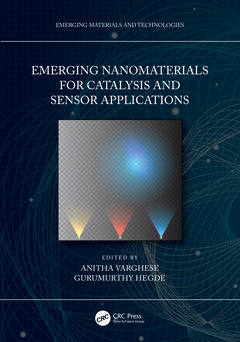Emerging Nanomaterials for Catalysis and Sensor Applications Emerging Materials and Technologies Series
Coordonnateurs : Varghese Anitha, Hegde Gurumurthy

This book reviews emerging nanomaterials in catalysis and sensors. The catalysis section covers the role of nano-photocatalysts in organic synthesis and health care application, oxidation and sulphoxidation reactions, liquid phase oxidation, hydrogen evolution and environmental remediation. It highlights the correlation of surface properties and catalytic activity of the mesoporous materials. The sensor section discusses the fabrication and development of various electrochemical, chemical, and biosensors.
Features:
- Combines catalysis and sensor applications of nanomaterials, including detailed synthesis techniques of these materials.
- Explores methods of designing, engineering, and fabricating nanomaterials.
- Covers material efficiency, their detection limit for sensing different analytes and other properties of the materials.
- Discusses sustainability of nano materials in the industrial sector.
- Includes case studies to address the challenges faced by research and development sectors.
This book is aimed at researchers and graduate students in Chemical Engineering, Nanochemistry, Water Treatment Engineering and Labs, Industries, Research Labs in Catalysis and Sensors, Environmental Engineering, and Process Engineering.
Section I: Emerging Materials in Nanocatalysis
1. The Role of Nanomaterials in Sustainable Organic Synthesis. 2. Nanocatalysts in Oxidation and Sulfoxidation Reactions. 3. Correlation of Surface Properties and Catalytic Activity of Metal Aluminophosphates. 4. Carbon Supported Noble Metal Nanocatalysts for Liquid Phase Oxidation Reactions. 5. Metal Oxide Nanomaterials for Visible Light Photocatalysis. 6. Progress in Photocatalysis for Hydrogen Evolution and Environmental Remediation.
Section II : Emerging Materials in Nanosensors
7. Nanostructured Materials for Sensors Applications. 8. Synthesis of Fluorescent Nanosensors for Biomedical Engineering. 9. Applications of Peptide Luminescent Nanosensors. 10. Graphene-Based Hybrid Nano Composites for Bio/Chemical Sensors. 11. Nanomaterial-Based Electrochemical Sensors for Vitamins and Hormones. 12. Economic Analysis, Environmental Impact, Future Prospects and Mechanistic Understandings of Nanosensors and Nanocatalysis.
Anitha Varghese obtained her PhD from Mangalore University, Karnataka, India in 2007, under the supervision of Dr A.M.A. Khader. Her PhD work concerned the sensing of heavy metal ions in various alloy steels, minerals, biological, soil, and water samples. In 2008, she started her career in CHRIST (Deemed to be University), Bengaluru, where she is a professor. Her current research interests include electrocatalysis for organic transformations and developing electrochemical sensors for biomolecules, flavonoids, pollutants, and food adulterants.
Gurumurthy Hegde obtained his PhD in liquid crystals in 2007 from the Centre for Nanomaterials and Soft Matter Science, Bengaluru. Expert in photoalignment and waste to wealth technologies, Dr Hegde has more than 18 years of R and D experience. His major research is in the field of liquid crystals, LCDs, nanoparticles, energy, water, and health. He has invented many concepts for aligning materials, waste to wealth technologies, and so forth. Presently he is working as the Director, Centre for Advanced Research and Development (CARD), CHRIST (Deemed to be University) and also as the Professor of Materials Science, Dept of Chemistry, CHRIST (Deemed to be University), Bengaluru. He has published more than 220 scientific publications and has more than 25 patents. He also has obtained more than 60 international awards and guided many PhD and MSc, MTech students.
Date de parution : 02-2023
17.8x25.4 cm
Thèmes d’Emerging Nanomaterials for Catalysis and Sensor Applications :
Mots-clés :
Organic Synthesis; Photocatalysts; Oxidation; Remediation; Fluoresence; Graphene; Coumarin-3 Carboxylic Acid; Modified Carbon Nanotube Paste Electrode; Anatase TiO; SERS Activity; Nitroxide Radicals; Fret; Fluorescence Resonance Energy Transfer; SERS Substrate; SERS Spectrum; Fluorescent Carbon Dots; Sulfoxidation Reactions; Non-metal Doping; Transition Metal; Nano Composites; Insulin Detection; BiOBr; WS; Photocatalytic Activity; Visible Light Photocatalysis; Electrochemical Sensor; GQDs; Atom Transfer Radical Addition; DSSC; Go; SERS



